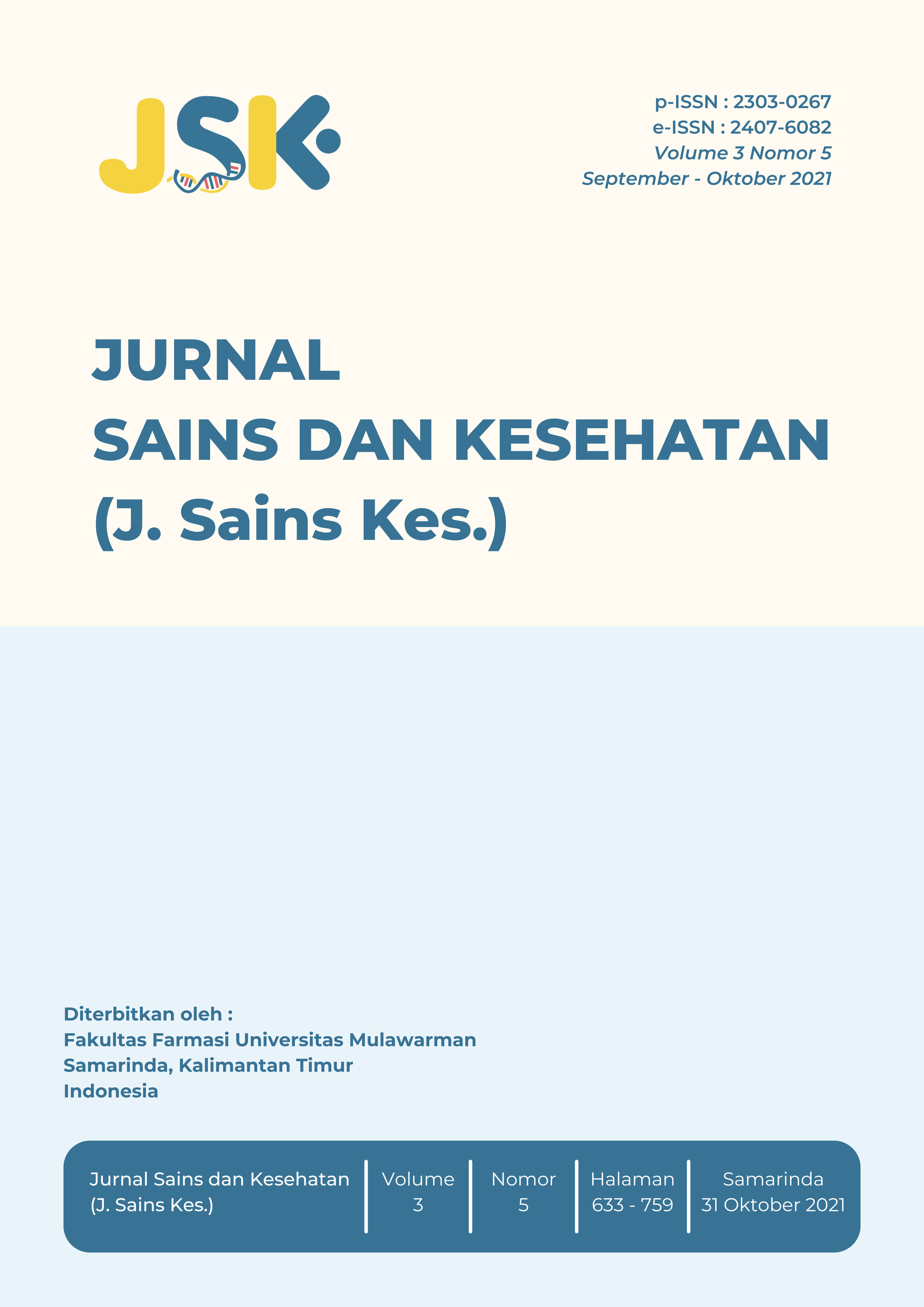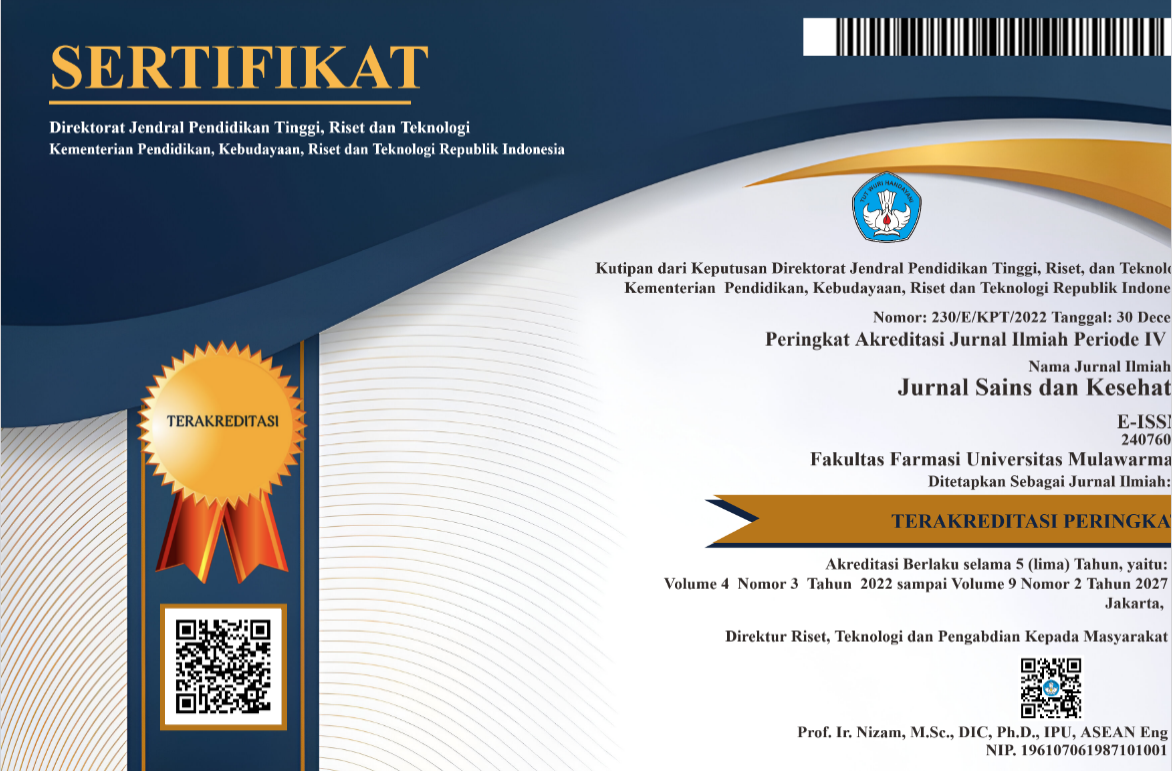Formulasi dan Karakterisasi Nanopartikel Kitosan Ekstrak Sari Buah Juwet (Syzygium cumini) menggunakan metode Gelasi Ionik
Formulation and characterization of Chitosan Nanoparticle of Juwet (Syzygium cumini) Fruit Extract Using Ionic Gelation Method
Keywords:
Gelasi Ionik, Kitosan, Nanopartikel, Syzygium cuminiAbstract
References
S. Nayak and M. Chandra, “Evaluation of bioactive compounds and antioxidant activity of some wild fruits by in-vitro assays,” International Journal of Pharmaceutical Sciences and Research, vol. 6, pp. 233–238
H. P. Gajera, S. N. Gevariya, D. G. Hirpara, S. V. Patel, and B. A. Golakiya, “Antidiabetic and antioxidant functionality associated with phenolic constituents from fruit parts of indigenous black jamun (Syzygium cumini L.) landraces,” Journal of Food Science and Technology, vol. 54, no. 10, pp. 3180–3191.
R. Gupta and A. M. Saxena, “Hypoglycemic and Anti-hyperglycemic Activities of Syzygium cumini (Linn.) Skeels Whole Fruit, in Normal and Streptozotocin-Induced Diabetic Rats,” Asian Journal of Pharmaceutical and Biological Research, vol. 1, no. 3, p. 7.
A. E.-M. M. Afify, S. A. Fayed, E. A. Shalaby, and H. A. El-Shemy, “Syzygium cumini (pomposia) active principles exhibit potent anticancer and antioxidant activities,” African Journal of Pharmacy and Pharmacology, vol. 5, no. 7, pp. 948–956.
M. Ayyanar and P. Subash-Babu, “Syzygium cumini (L.) Skeels: A review of its phytochemical constituents and traditional uses,” Asian Pacific Journal of Tropical Biomedicine, vol. 2, no. 3, pp. 240–246.
A. Banerjee, N. Dasgupta, and B. De, “In vitro study of antioxidant activity of fruit,” Food Chemistry, vol. 90, no. 4, pp. 727–733.
J. P. Singh et al., “In vitro antioxidant and antimicrobial properties of jambolan (Syzygium cumini) fruit polyphenols,” LWT - Food Science and Technology, vol. 65, pp. 1025–1030.
B. Chaudhary and K. Mukhopadhyay, “Syzygium cumini (L.) skeel?: a potential source of nutraceuticals,” International Journal of Pharmacy and Biological Sciences, vol. 2, no. 1, pp. 46–53.
J. Veigas, M. Narayan, P. Laxman, and B. Neelwarne, “Chemical nature, stability and bioefficacies of anthocyanins from fruit peel of syzygium cumini Skeels,” Food Chemistry, vol. 105, no. 2, pp. 619–627.
R. K. Bijauliya, S. Alok, M. Singh, and S. B. Mishra, “Morphology, phytochemistry and pharmacology of Syzygium cumini (Linn.) - an overview,” International Journal of Pharmaceutical Sciences and Research, vol. 8, no. 6, pp. 2360–2371.
S. Ramya, K. Neethirajan, and R. Jayakumararaj, “Profile of bioactive compounds in Syzygium cumini – a review,” Journal of Pharmacy Research, no. 8, p. 7.
V. Thorat, “Syzygium cumini?: a review,” International Journal of Pharmacognosy, vol. 4, no. 10, pp. 320–331.
B. Singh, J. P. Singh, A. Kaur, and N. Singh, “Insights into the phenolic compounds present in jambolan (Syzygium cumini) along with their health-promoting effects,” International Journal of Food Science & Technology, vol. 53, no. 11, pp. 2431–2447.
A. Liazid, M. Palma, J. Brigui, and C. G. Barroso, “Investigation on phenolic compounds stability during microwave-assisted extraction,” Journal of Chromatography A, vol. 1140, no. 1–2, pp. 29–34.
T. A. Comunian, R. Ravanfar, I. A. de Castro, R. Dando, C. S. Favaro-Trindade, and A. Abbaspourrad, “Improving oxidative stability of echium oil emulsions fabricated by Microfluidics: Effect of ionic gelation and phenolic compounds,” Food Chemistry, vol. 233, pp. 125–134.
W. Hajrin, “Formulasi Mikropartikel Ekstrak Etanol Herba Meniran (Phyllanthus niruri) Menggunakan Polimer Kitosan dan Na-TPP Serta Uji Aktivitas Imunomodulator Secara In Vivo,” Tesis, Universitas Gadjah Mada Yogyakarta.
G. Pratiwi, R. Martien, and R. Murwanti, “Chitosan nanoparticle as a delivery system for polyphenols from meniran extract (Phyllanthus niruri L)?: formulation, optimization, and immunomodulatory activity,” Int J App Pharm, pp. 50–58.
M. George and T. E. Abraham, “Polyionic hydrocolloids for the intestinal delivery of protein drugs: Alginate and chitosan — a review,” Journal of Controlled Release, vol. 114, no. 1, pp. 1–14.
Y.-H. Lin et al., “Multi-ion-crosslinked nanoparticles with pH-responsive characteristics for oral delivery of protein drugs,” Journal of Controlled Release, vol. 132, no. 2, pp. 141–149.
W. Tiyaboonchai, “Chitosan Nanoparticles: A Promising System for Drug Delivery,” Naresuan University Journal, vol. 11, no. 3, pp. 51–66.
P. D. Apsari and H. Susanti, “Perbandingan kadar fenolik total ekstrak metanol kelopak merah dan ungu bunga rosella,” p. 6.
P. Hariyadi, “Pengeringan beku dan aplikasinya di industri pangan,” Food Review, vol. 8, no. 1, pp. 52–56.
J. Suryadi, “Daya antioksidan ekstrak etanol kulit buah manggis (Garcinia mangostana L.) pengeringan matahari langsung dan freeze- drying,” Jurnal Ilmiah Mahasiswa Universitas Surabaya, vol. 2, no. 1, pp. 1–19.
B. B. Sembiring, “garuh konsentrasi bahan pengisi dan cara pengeringan terhadapmutu ekstrak kering sambiloto,” Buletin Penelitian Tanaman Rempah dan Obat, vol. 20, no. 2.
R. Alfian and H. Susanti, “Penetapan kadar fenolik total ekstrak metanol kelopak bunga rosella merah (Hibiscus sabdariffa Linn) dengan variasi tempat tumbuh secara spektrofometri,” Jurnal Ilmiah Kefarmasian, vol. 2, no. 1, pp. 73–80.
E. H. Imad, M. Didi, F. Bekkara, and M. Gherib, “In vitro antioxidant activity and total phenolic contents in methanol crude extracts from the Algerian medicinal plant Limoniastrum feei,” Scientific Study and Research, vol. 10, no. 4, pp. 329–336.
M. Sahumena, “Pengembangan nanopartikel ketoprofen dengan teknik SNEDDS dan uji aktifitas antiinflamasi,” Tesis, vol. Yogyakarta?:Program Pasca Sarjana Universitas Gadjah Mada.
S. Arora and R. D. Budhiraja, “Chitosan-alginate microcapsules of amoxicillin for gastric stability and mucoadhesion,” J Adv Pharm Technol Res, vol. 3, no. 1, pp. 68–74.
J. Berger, M. Reist, J. M. Mayer, O. Felt, N. A. Peppas, and R. Gurny, “Structure and interactions in covalently and ionically crosslinked chitosan hydrogels for biomedical applications,” European Journal of Pharmaceutics and Biopharmaceutics, vol. 57, no. 1, pp. 19–34.
K. Dupinder and S. Seema, “Variables effecting drug entrapment efficiency of microspheres: a review,” International Research Journal of Pharmaceutical and Applied Sciences, vol. 3, no. 3.
J. Fu et al., “High Entrapment Efficiency of Chitosan/Polylactic Acid/Tripolyphotspate Nanosized Microcapsules for Rapamycin by an Emulsion-Evaporation Approach,” Journal of Biomedical Nanotechnology, vol. 6, no. 6, pp. 725–728.
K. S. Shalaby et al., “Determination of factors controlling the particle size and entrapment efficiency of noscapine in PEG/PLA nanoparticles using artificial neural networks,” Int J Nanomedicine, vol. 9, pp. 4953–4964.
J. Jeevanandam, A. Barhoum, Y. S. Chan, A. Dufresne, and M. K. Danquah, “Review on nanoparticles and nanostructured materials: history, sources, toxicity and regulations,” Beilstein J. Nanotechnol., vol. 9, pp. 1050–1074.
N. H. C. Marzuki, R. A. Wahab, and M. A. Hamid, “An overview of nanoemulsion: concepts of development and cosmeceutical applications,” Biotechnology & Biotechnological Equipment, vol. 33, no. 1, pp. 779–797.
W. Rakhmaningtyas, “Preparasi dan karakterisasi nanopartikel sambungsilang kitosan-natrium tripolifosfat dalam sediaan film bukal verapamil hidroklorida,” FMIPA Universitas Indonesia, Jakarta.
A. Nasr, A. Gardouh, H. Ghonaim, E. Abdelghany, and M. Ghorab, “Effect of oils, surfactants and cosurfactants on phase behavior and physicochemical properties of self-nanoemulsifying drug delivery system (SNEDDS) for irbesartan and olmesartan,” International Journal of Applied Pharmaceutics, vol. 8, no. 1, pp. 13–24.
N. Parmar, N. Singla, S. Amin, and K. Kohli, “Study of cosurfactant effect on nanoemulsifying area and development of lercanidipine loaded (SNEDDS) self nanoemulsifying drug delivery system,” Colloids Surf B Biointerfaces, vol. 86, no. 2, pp. 327–338.
Downloads
Published
Issue
Section
How to Cite
Most read articles by the same author(s)
- Novita Eliya Wardani, Windah Anugrah Subaidah, Handa Muliasari, Ekstraksi dan Penetapan Kadar Glukomanan dari Umbi Porang (Amorphophallus muelleri Blume) Menggunakan Metode DNS , Jurnal Sains dan Kesehatan: Vol. 3 No. 3 (2021): J. Sains Kes.
- M. Elyadi, Windah Anugrah Subaidah, Handa Muliasari, Formulasi dan Uji Aktivitas Antiradikal Bebas Emulgel Ekstrak Daun Juwet (Syzygium cumini L.) dengan Metode DPPH (Diphenilpycrylhydrazil) , Jurnal Sains dan Kesehatan: Vol. 3 No. 3 (2021): J. Sains Kes.
Similar Articles
- Damaranie Dipahayu, Galuh Gondo Kusumo, Formulasi dan Evaluasi Nano Partikel Ekstrak Etanol Daun Ubi Jalar Ungu (Ipomoea batatas L.) Varietas Antin-3 , Jurnal Sains dan Kesehatan: Vol. 3 No. 6 (2021): J. Sains Kes.
- Deni Rahmat, Dian Ratih L., Liliek Nurhidayati, Meilda Ayu Bathini, Peningkatan Aktivitas Antimikroba Ekstrak Nanas (Ananas comosus (L.). Merr) dengan Pembentukan Nanopartikel , Jurnal Sains dan Kesehatan: Vol. 1 No. 5 (2016): J. Sains Kes.
- M. Elyadi, Windah Anugrah Subaidah, Handa Muliasari, Formulasi dan Uji Aktivitas Antiradikal Bebas Emulgel Ekstrak Daun Juwet (Syzygium cumini L.) dengan Metode DPPH (Diphenilpycrylhydrazil) , Jurnal Sains dan Kesehatan: Vol. 3 No. 3 (2021): J. Sains Kes.
- Firkatun Naziah, Maryam Jamila Arief, Efektivitas Antijamur Dari Ekstrak dan Sediaan Salep Daun Jamblang (Syzygium cumini L.) Terhadap Malassezia furfur Penyebab Ketombe , Jurnal Sains dan Kesehatan: Vol. 6 No. 3 (2025)
- Andi Fahrurroji, Bambang Wijianto, Agus Styawan, Formulasi dan Evaluasi Hidrogel Mukoadhesif Metronidazole Menggunakan Kombinasi Kitosan dan Natrium Karboksimetilselulosa , Jurnal Sains dan Kesehatan: Vol. 2 No. 3 (2020): J. Sains Kes.
- Valentina Adimurti Kusumaningtyas, Tia Setiawati, Lia Dewi Juliawaty, Yana Maolana Syah, Melina Melina, Trisna Yuliana, Sukrido Sukrido, Senadi Budiman, Hernandi Sujono, Devitri Amisa, Endang Rosdiana, Moluskisida Kombinasi Mikroenkapsulasi Daun Kacang Babi, Daun Serai Wangi, dan Kitosan sebagai Pembasmi Keong Mas pada Tanaman Padi , Jurnal Sains dan Kesehatan: Vol. 2 No. 4 (2020): J. Sains Kes.
- Fatimah Az-Zhahra, Nisa Naspiah, Lizma Febrina, Rolan Rusli, Sintesis Nanopartikel Perak Menggunakan Ekstrak Metanol Daun Nipah (Nypa fruticans) sebagai Agen Antibakteri , Jurnal Sains dan Kesehatan: Vol. 2 No. 3 (2020): J. Sains Kes.
- Nurul Hidayatri, Deni Rahmat, Agung Eru Wibowo, Aktivitas Penghambatan Enzim Tirosinase Secara In Vitro Solid Lipid Nanopartikel Tetrahidrokurkumin , Jurnal Sains dan Kesehatan: Vol. 3 No. 6 (2021): J. Sains Kes.
- Yunita Diyah Safitri, Novintan Elistya Dyah Purnamawati, Perbandingan Aktivitas Antibakteri Ekstrak Methanol Gagang dan Bunga Cengkeh (Syzygium Aromaticum) terhadap Bakteri Staphylococcus aureus ATCC 25923 , Jurnal Sains dan Kesehatan: Vol. 3 No. 3 (2021): J. Sains Kes.
- Asti Vebriyanti Asjur, Karakterisasi Fungi Endofit Syzygium polyanthum (Wight) Walp. Berdasarkan Gen ITS Sebagai Penghasil Senyawa Antibakteri , Jurnal Sains dan Kesehatan: Vol. 3 No. 3 (2021): J. Sains Kes.
You may also start an advanced similarity search for this article.




